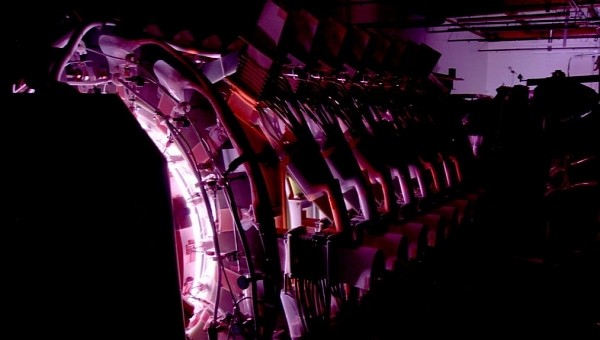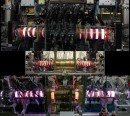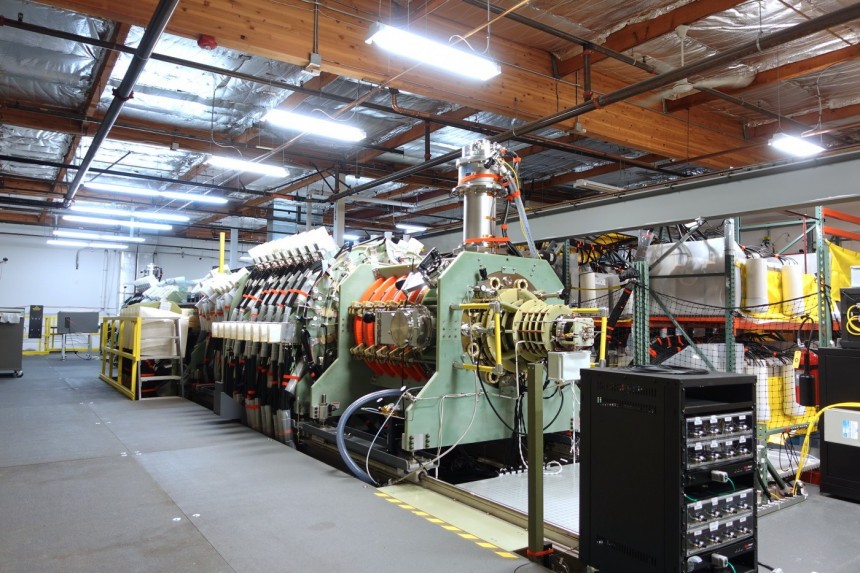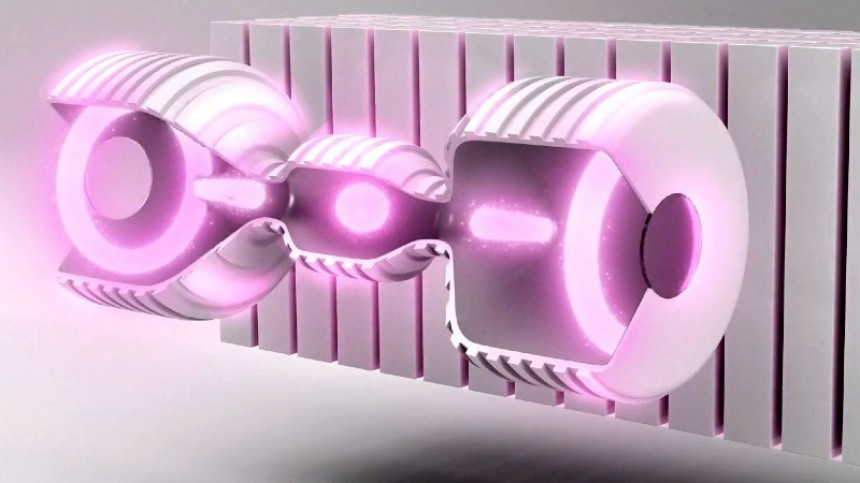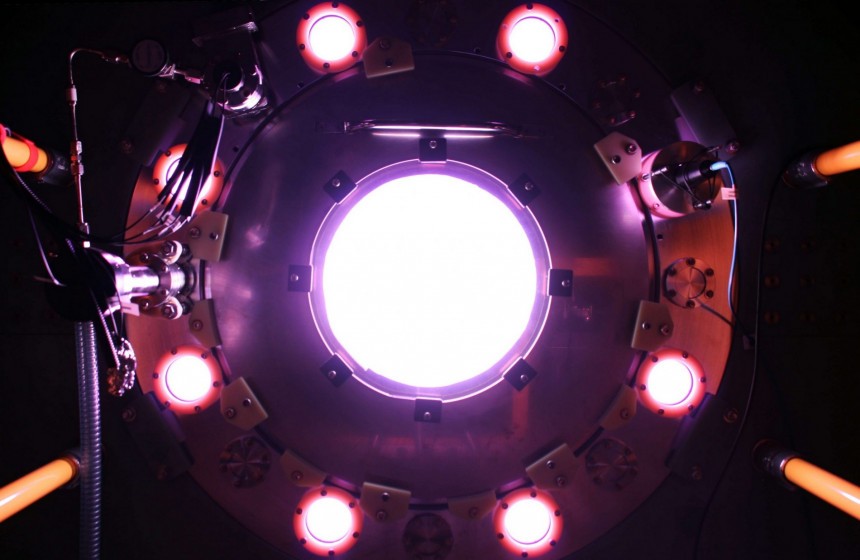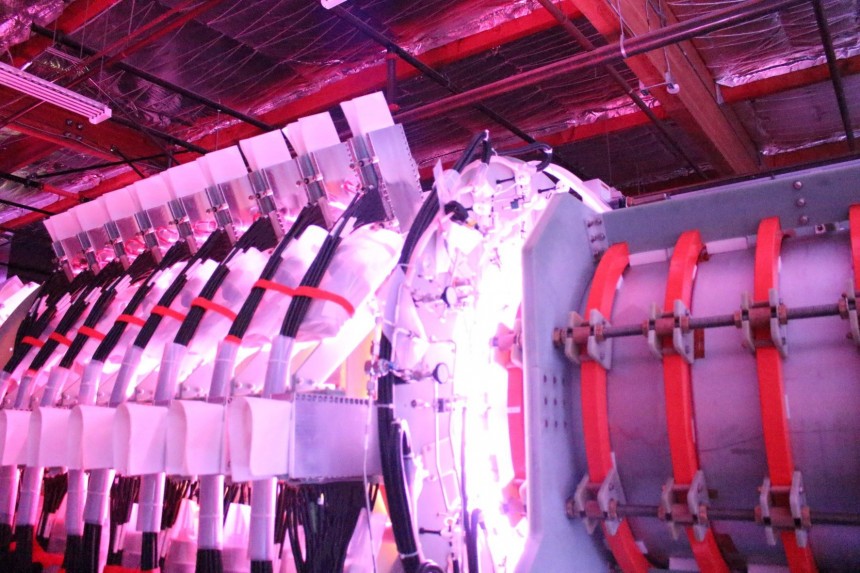A surprisingly small footprint, immensely powerful, and able to be shoved under the hood of just about anything. These are some of the traits that constitute a great sports car engine, your General Motors LS V8s and such. Because of Helion Energy, we know this applies to nuclear fusion reactors as well.
By her own admission the Communications Lead at Helion Energy is no gearhead. But that doesn't mean the parking lot of the company she works for isn't full of Teslas, Chevy Volts, Rivians, and Polestars. She was still graciously willing to sit down with autoevolution to help explain how the nuclear fusion reactors her co-workers designed mimic an internal combustion engine in a positively uncanny way.
For those who have yet to see our report on Helion Energy's remarkable Trenta fusion reactor, the company was founded in 2013 in Redmond, Washington. Its new HQ in the nearby City of Everett now plays host to some genuinely groundbreaking fusion experiments. With only 135 team members, this crack group of scientists, engineers, and energy sector personnel turn what most assume is a pie-in-the-sky notion into practical reality.
"Our team was originally founded by Dr. David Kirtley, Chris Pihl, Dr. George Votroubek, as well as Dr. John Slough. It was a spinoff from a company called MS&W, which was doing research in applications for space propulsion." our Helion rep stated about Helion's eclectic and sci-fi adjacent origin story. Small wonder the original blueprints for Helion reactors were classified internally as fusion engines.
Rest assured, it's all real, as the public only recently had a glimpse at Helion's one-of-a-kind and novel nuclear fusion in the form of their seventh-generation reactor, the Trenta. But you might be familiar with more traditional forms of nuclear fusion, such as the Tokamak-class reactors at the Joint European Torus (JET) laboratory in the U.K. or the ITER facility in France, among others. But as you'll find, comparing Helion's brand of fusion to a Tokamak is like comparing a Ferrari to a lifted pickup truck.
"Our approach to fusion is fairly different than the Tokamak reactors you see at both ITER and JET," our rep explained. "Instead of this big donut machine, you can imagine having just like a Pringles tube, for instance, and it is wrapped with sequenced electromagnets that switch on and off. The electromagnets around the machine control a plasma that's in the middle of the machine. That plasma is where the fusion happens."
Though we're far from nuclear engineers, our rep did a wonderful job explaining things in a way regular folks can understand. To begin, a combination of deuterium and helium-3 isotopes is injected into an internal formation chamber at either end of each cylinder. It's a process almost reminiscent of the compression section of a jet engine or the fuel injectors in a car. Once completed, a series of electromagnets superheat and pressurize the gas inside the chamber. Forming two identical rings of plasma as subatomic particles separate from their host atoms.
In what's known as a field-reverse configuration (FRC), each ring of plasma is forced to smash into each other through a powerful electromagnetic force at up to one million miles per hour (300 km/sec). The resulting hyper-heated, hyper-pressurized plasma meets in the middle of the reactor. Thus leaving the atomic particles in said plasma to fuse into helium-4 plus an extra hydrogen atom.
By the time this plasma reaches the main compressor section, the two fields of plasma have traveled at unbelievable speeds before suddenly coming to a stop, similar to a car crash on a microscopic scale. The results are a fusion-pulse reaction that burns at around 100 million degrees Fahrenheit (55 million degrees Celsius). But if you ask our Helion rep, she'll tell you field-reverse configurations acting like an artificial sun of sorts have more than a few benefits despite the immense forces to contend with.
"The main benefit of FRC that I'll call out is that it has a very high beta," our rep said of Helion's unique brand of fusion. "When we talk about beta in plasma physics, it's the ratio of the pressure inside the plasma versus the rate ratio of the pressure outside the plasma. So imagine you had a balloon and you blew it up with air, and if you only blew it up with a little bit of air and you pressed on it. It would probably condense, and you could like, push on it more. But the more air you put into it, the harder it gets to push in on that balloon's surface."
Using Faraday's law of induction, the electricity generated from this biblical-looking fusion reaction can be harnessed via fiber-optic cables and discharged through a series of supercapacitors not too dissimilar to the ones you'd charge up a dead car battery with. The big difference is these capacitors are nothing short of massive.
"It's because of all this that we can totally bypass a steam cycle you'd have in, like a fission reactor or even a Tokamak fusion reactor. We're skipping right to direct electricity or electricity recapture," said our rep. "One of the parallels that we draw often is if you think about how regenerative braking works in an electric vehicle that's done through magnets, it's the same working principle."
But before this takes place, electromagnetic pressure waves inside the fusion chamber force the fusion fuel through the reactor. As if like an internal-combustion engine's piston compressing air and fuel and then mixing it with a spark, this immense electromagnetic pressure works on the very same principle. Any excess gasses are vented out and collected via a massive 33,000 rpm turbopump not too dissimilar to the turbine blades of a jet engine; or even the turbocharger in your car. Garret 88mm fanboys, eat your hearts out.
This magnetic field works double duty, keeping the unimaginably hot reaction from touching the inner walls of the fusion chamber. Less than a month has gone by since the Real Engineering YouTube channel was granted unparalleled access to see Trenta. But already, this novel reactor is in the process of disassembly to see how its fusion chamber handled nuclear reactions in excess of tens of millions of degrees.
Though the business of actually harnessing electricity is a task reserved for Trenta's successor, Project Polaris, a full-scale commercial reactor should be in the cards sometimes soon afterward. If you ask us, it won't be a moment too soon. There's a global energy crisis in our midst, disastrously timed with the rise of the all-electric revolution in the automotive sector.
All those Tesla Superchargers and state/county standardized charge stations of the future need to keep the juice flowing one way or another. For the moment, the bulk of this energy is sourced from substances that can only be described as the antithesis of eco-friendly. But one of Helion's more brilliant secondary objectives, besides building the world's first commercial fusion reactor, is supplying a theoretically limitless supply of clean, carbon-free energy for just such an occasion.
It's all in a form factor that's designed to be scaled down to something that fits dozens of different types of facilities. From on-site power generation stations to replacing entire coal/nat-gas stations with a single reactor or even a cluster of several working in parallel. Sounds better than a meltdown-prone fission reactor every day of the week. Not that modern fission reactors don't have a fantastic safety record post-Fukushima. That won't stop skeptics from claiming nuclear fusion isn't an endeavor worth trifling with.
"It's important to recognize that fusion and fission are basically totally different processes. I like to think about black and white. They're both colors, but if you look at them on a scale like they're opposite of each other, right? So that's what you can see about Fusion. Fission involves breaking apart molecules. Fusion is bringing those together," our rep professed. "With that, there comes a totally different safety profile. So, for instance, fission might create radioactive waste for tens of thousands of years. For fusion, there is some radioactive waste, but that has a half-life of 12 years. So we're looking at much different timescales."
With the right amount of funding and wide-scale implementation that should solve the dirty EV-charging problem, environmental experts won't stop screaming about from the rooftops. It was a genuine challenge for automotive experts to ascertain exactly how nuclear fusion would have effects on forces in our sector. But after our chat with Helion, it's clear that the effects of nuclear fusion on the auto industry will simply be collateral benefits of the post-fossil-fuel era.
"We always need energy. It needs to be cost-effective. So it needs to be affordable. We also need it to be able to be deployed fast enough to make a difference. If we're going to electrify the grid, which we're doing at a rapid rate." our rep explained to conclude our chat. "It's our goal to meet those needs. It will take time. So we, but our focus right now is on getting to net electricity and Polaris and then the conversion, our first commercial generator will follow, so we can start on that."
We'd like to thank Helion Energy for sitting down with us motoring journalists and walking us through what their fusion reactor is all about. Learning how their frankly mind-blowing fusion technology may one day have effects on our own neck of the woods was nothing short of a treat. If you ask us, we may be prime to see the fruits of Helion's efforts sooner than you think. What a wonderful time to be alive!
For those who have yet to see our report on Helion Energy's remarkable Trenta fusion reactor, the company was founded in 2013 in Redmond, Washington. Its new HQ in the nearby City of Everett now plays host to some genuinely groundbreaking fusion experiments. With only 135 team members, this crack group of scientists, engineers, and energy sector personnel turn what most assume is a pie-in-the-sky notion into practical reality.
"Our team was originally founded by Dr. David Kirtley, Chris Pihl, Dr. George Votroubek, as well as Dr. John Slough. It was a spinoff from a company called MS&W, which was doing research in applications for space propulsion." our Helion rep stated about Helion's eclectic and sci-fi adjacent origin story. Small wonder the original blueprints for Helion reactors were classified internally as fusion engines.
Rest assured, it's all real, as the public only recently had a glimpse at Helion's one-of-a-kind and novel nuclear fusion in the form of their seventh-generation reactor, the Trenta. But you might be familiar with more traditional forms of nuclear fusion, such as the Tokamak-class reactors at the Joint European Torus (JET) laboratory in the U.K. or the ITER facility in France, among others. But as you'll find, comparing Helion's brand of fusion to a Tokamak is like comparing a Ferrari to a lifted pickup truck.
Though we're far from nuclear engineers, our rep did a wonderful job explaining things in a way regular folks can understand. To begin, a combination of deuterium and helium-3 isotopes is injected into an internal formation chamber at either end of each cylinder. It's a process almost reminiscent of the compression section of a jet engine or the fuel injectors in a car. Once completed, a series of electromagnets superheat and pressurize the gas inside the chamber. Forming two identical rings of plasma as subatomic particles separate from their host atoms.
In what's known as a field-reverse configuration (FRC), each ring of plasma is forced to smash into each other through a powerful electromagnetic force at up to one million miles per hour (300 km/sec). The resulting hyper-heated, hyper-pressurized plasma meets in the middle of the reactor. Thus leaving the atomic particles in said plasma to fuse into helium-4 plus an extra hydrogen atom.
By the time this plasma reaches the main compressor section, the two fields of plasma have traveled at unbelievable speeds before suddenly coming to a stop, similar to a car crash on a microscopic scale. The results are a fusion-pulse reaction that burns at around 100 million degrees Fahrenheit (55 million degrees Celsius). But if you ask our Helion rep, she'll tell you field-reverse configurations acting like an artificial sun of sorts have more than a few benefits despite the immense forces to contend with.
Using Faraday's law of induction, the electricity generated from this biblical-looking fusion reaction can be harnessed via fiber-optic cables and discharged through a series of supercapacitors not too dissimilar to the ones you'd charge up a dead car battery with. The big difference is these capacitors are nothing short of massive.
"It's because of all this that we can totally bypass a steam cycle you'd have in, like a fission reactor or even a Tokamak fusion reactor. We're skipping right to direct electricity or electricity recapture," said our rep. "One of the parallels that we draw often is if you think about how regenerative braking works in an electric vehicle that's done through magnets, it's the same working principle."
But before this takes place, electromagnetic pressure waves inside the fusion chamber force the fusion fuel through the reactor. As if like an internal-combustion engine's piston compressing air and fuel and then mixing it with a spark, this immense electromagnetic pressure works on the very same principle. Any excess gasses are vented out and collected via a massive 33,000 rpm turbopump not too dissimilar to the turbine blades of a jet engine; or even the turbocharger in your car. Garret 88mm fanboys, eat your hearts out.
Though the business of actually harnessing electricity is a task reserved for Trenta's successor, Project Polaris, a full-scale commercial reactor should be in the cards sometimes soon afterward. If you ask us, it won't be a moment too soon. There's a global energy crisis in our midst, disastrously timed with the rise of the all-electric revolution in the automotive sector.
All those Tesla Superchargers and state/county standardized charge stations of the future need to keep the juice flowing one way or another. For the moment, the bulk of this energy is sourced from substances that can only be described as the antithesis of eco-friendly. But one of Helion's more brilliant secondary objectives, besides building the world's first commercial fusion reactor, is supplying a theoretically limitless supply of clean, carbon-free energy for just such an occasion.
It's all in a form factor that's designed to be scaled down to something that fits dozens of different types of facilities. From on-site power generation stations to replacing entire coal/nat-gas stations with a single reactor or even a cluster of several working in parallel. Sounds better than a meltdown-prone fission reactor every day of the week. Not that modern fission reactors don't have a fantastic safety record post-Fukushima. That won't stop skeptics from claiming nuclear fusion isn't an endeavor worth trifling with.
With the right amount of funding and wide-scale implementation that should solve the dirty EV-charging problem, environmental experts won't stop screaming about from the rooftops. It was a genuine challenge for automotive experts to ascertain exactly how nuclear fusion would have effects on forces in our sector. But after our chat with Helion, it's clear that the effects of nuclear fusion on the auto industry will simply be collateral benefits of the post-fossil-fuel era.
"We always need energy. It needs to be cost-effective. So it needs to be affordable. We also need it to be able to be deployed fast enough to make a difference. If we're going to electrify the grid, which we're doing at a rapid rate." our rep explained to conclude our chat. "It's our goal to meet those needs. It will take time. So we, but our focus right now is on getting to net electricity and Polaris and then the conversion, our first commercial generator will follow, so we can start on that."
We'd like to thank Helion Energy for sitting down with us motoring journalists and walking us through what their fusion reactor is all about. Learning how their frankly mind-blowing fusion technology may one day have effects on our own neck of the woods was nothing short of a treat. If you ask us, we may be prime to see the fruits of Helion's efforts sooner than you think. What a wonderful time to be alive!
